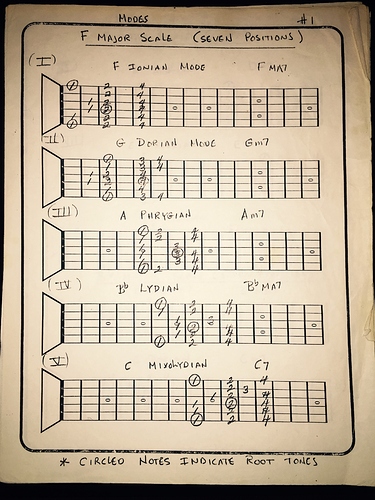Hey everyone!
I will try to make my question(s) as clear as I can. Theory and its application can be difficult as there are many schools of thought and no “one way” to approach soloing, etc.
BACKGROUND- So I have been working on my 3NPS patterns and have several musician friends that are of 2 camps of thought-
- Learn your 3NPS scales/modes- all 7 of them inside and out cold. Once you have that down, know your root notes cold too. With that knowledge in hand whatever backing track you are playing over, you can plug and play those scales in over the harmony. So if you have a C Lydian backing track, find your C notes, plug in the Lydian pattern, and voila. I know I am simplifying but that is the gist of it.
- Don’t be too concerned about scale patterns in the sense of- if I play the Ionian scale on the root, then its Ionian. If I start on the 2nd note, it is now Dorian. Therefore the shape is not as important as you may think it is. The greater concern is being sensitive to the harmony of your song.
- At this point in my scale knowledge and implementation, I break up 3NPS scales into 3 fragments (2 strings per fragment (357 357 is one, 457 457 is two, and 578 578 is three if we are using G major as our starting point) and can build those fragments anywhere on the guitar knowing where my root notes are. Steve Gilson on YT has a great demonstration of this. I don’t think yet in terms of the modal names, but focus on the root notes and can build my scales around them wherever I am at on the fret board.
Now both these camps are lifelong musicians one of which graduated with honors from Berklee and is a live performer himself. So I must give respect where respect is due and analyze all approaches with equal weight.
My questions with all this being said are:
- When soloing over a particular mode you must be sensitive to the harmony. Meaning, F Lydian is a mode of C major. However, a C major backing track and an F Lydian backing track sound very different. Both scale shapes are the same on the fret board, same exact notes in the scale, but the harmony is different. So when you are soloing, do you think of the parent scale to find your patterns on the guitar? What is your personal visualization technique for hitting the right notes? For me to think F Lydian to E Phrygian, OK now to D Dorian, and the parent is C major seems cumbersome at best.
- I find it somewhat easy now to be playing a pentatonic position and look to my left and to my right of it and feel good with my relative positions. My solos don’t sound as smooth as I want lol but I can navigate horizontally. The issue at the moment is to do the same thing with our pentatonic scales and to implement this with the modes.
- Let’s say we are playing in A minor, ala Mr. Wylde’s favorite key
 A minor and C major share the same notes, but our starting and stopping points are different. Using A minor, how do you visualize building the scales to the left and to the right of 578 578 on the low E string? My thought is to visualize C major and try to play with an A root focus. Probably wrong but best ATM.
A minor and C major share the same notes, but our starting and stopping points are different. Using A minor, how do you visualize building the scales to the left and to the right of 578 578 on the low E string? My thought is to visualize C major and try to play with an A root focus. Probably wrong but best ATM.
Thank you for reading this and look forward to any replies- Bullseye.









 ), how do you recommend using those patterns to stay in key and apply them with no thinking involved as you say?
), how do you recommend using those patterns to stay in key and apply them with no thinking involved as you say?


